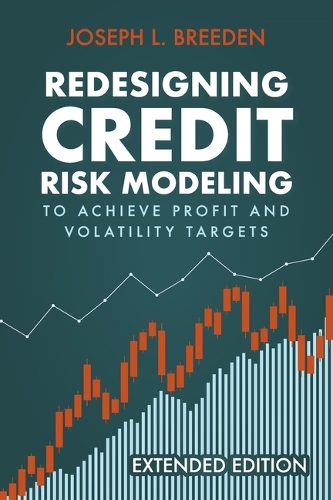
Redesigning Credit Risk Modeling to Achieve Profit and Volatility Targets
(Paperback)
Publishing Details
Redesigning Credit Risk Modeling to Achieve Profit and Volatility Targets
By (Author) Joseph L. Breeden
BookBaby
BookBaby
29th April 2025
United States
Classifications
Physical Properties
Paperback
140
Width 152mm, Height 228mm
Description
Why does performance by bureau score change so radially through the credit cycle Why do we have cut-off scores Why do machine learning models degrade so fast when deployed, and do they need to What is the real purpose of alternate data What are the true dimensions of borrower behavior that we need to understand Why isn't forecast uncertainty included in underwriting Why do applications of Modern Portfolio Theory fail for loan portfolios
These questions and many more are answered in this integrated approach to credit risk analytics. Credit risk analysts are not tapping the real power of machine learning and alternate data, because their models are built in a 1960s scoring architecture. Changing the architecture not only solves problems of overfitting and out-of-time degradation, but it also turns machine learning models into cash flow forecasters that integrate directly with yield and NPV models in finance. When account-level forecasts directly predict yield, underwriting decisions can be based on financial targets directly, rather than judgmental, backward-looking score cutoffs.
The material is presented conceptually with a focus on analytic methods with business value. To solve these decades-long mysteries, the industry must break free of the 1960s mindset of how analytics should be used in credit risk, and this book lights the way.
Reviews
Dr. Breeden's proposal to leveraging the age-period-cohort loss forecasting methodology for loan approval and pricing is both fresh and innovative. He supports his thesis well for both why it's overdue, needed and why it could work operationally while getting "CARL's" permission. The banking industry is overdue for a modified approach to leveraging data and models for loan underwriting and pricing. -Charles Maner, Head of Retail Credit Risk Model Development, Truist Financial
Although the financial world has changed out of all recognition, consumer credit risk modelling remains almost the same as it was in 1980: scorecards adjusted for immediate purposes. This book shows how credit risk models are at last changing. The need for change is clear. This book describes the use cases that scorecards struggle to support: robust time-tracking and scenario treatment, the granular and dynamic modelling power of machine learning, and managing customers using AI. For these cases, the book shows the way for classic scorecards and credit decisioning to evolve and grow. - Alan Forrest, Business Associate at the University of Edinburgh Business School, after over 20 years of employment in UK Financial services including Virgin Money UK, Royal Bank of Scotland and Halifax Bank of Scotland
Author Bio
CEO, Deep Future Analytics LLC (Deepfutureanalytics.com)
President, Model Risk Managers' International Assocation (MRMIA.org)
Dr. Breeden has been designing and deploying risk management systems for loan portfolios since 1996. He founded Deep Future Analytics in 2011, which focuses on portfolio and loan-level forecasting solutions for pricing, account management, stress testing, and CECL; serving banks, credit unions, and finance companies. He is also the owner of auctionforecast.com, which predicts the values of fine wines using a proprietary database with over 4.5 million auction prices.
He is a member of the board of directors of Upgrade, a San Francisco-based FinTech; an Associate Editor for the Journal of Credit Risk, the Journal of Risk Model Validation, the Journal of Risk and Financial Management and the journal AI and Ethics; and President of the Model Risk Managers' International Association (mrmia.org).
Dr. Breeden invented vintage analytics for lending in 1997 and created credit risk models through the 1995 Mexican Peso Crisis, the 1997 Asian Economic Crisis, the 2001 Global Recession, the 2003 Hong Kong SARS Recession, the 2007-2009 US Mortgage Crisis and Global Financial Crisis, and the COVID-19 Pandemic. These crises have provided Dr. Breeden with a rare perspective on crisis management and the analytics needs of executives for strategic decision-making. In 2018 Dr. Breeden invented Multihorizon Survival modeling, combining vintage analytics with behavior scoring using logistic regression or machine learning.
Dr. Breeden earned a Ph.D. in physics, and has published over 90 academic articles, 8 patents, and 6 books
